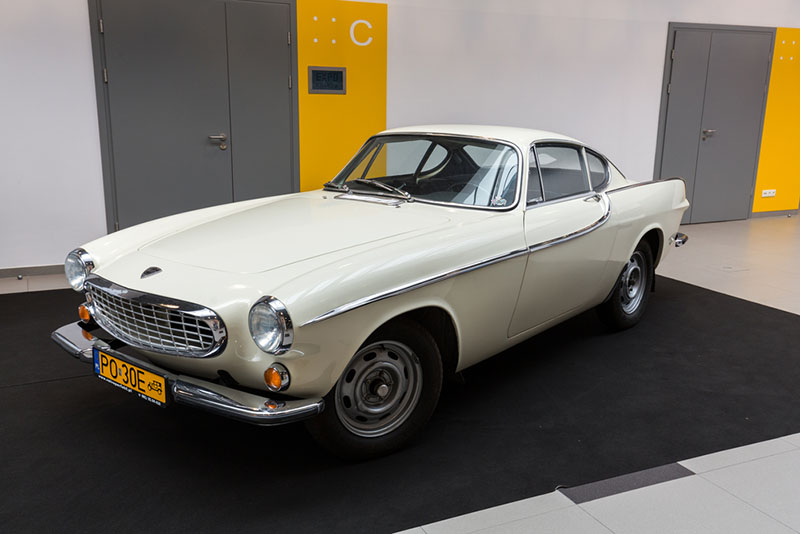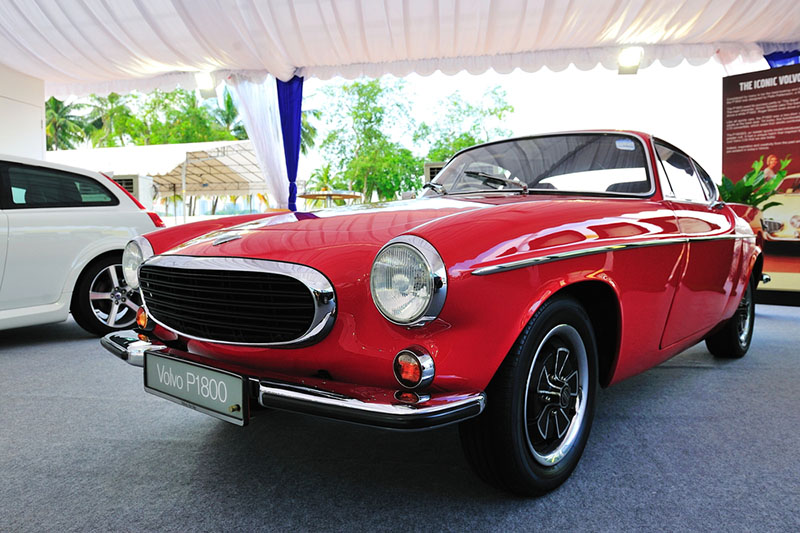Sell my Classic Volvo P1800
Production
1961–1973
39,407 notch coupé
8,077 sports estate
Technical Information
Assembly
West Bromwich, England (Jensen Motors, 1961–62)
Torslanda, Sweden (1963–1973)
Gothenburg, Sweden (1963–1973)
Designer
Pelle Petterson
Body and chassis
Class
Sports car (S)
Body style
2-door coupe
3-door sports estate
Layout
FR layout
Related
Volvo Amazon
Powertrain
Engine
1,778 cc B18 I4
1,986 cc B20B/E/F I4
Transmission
4-speed M40 manual
4-speed M41 manual with Laycock overdrive
3-speed Borg-Warner 35 automatic
Dimensions
Wheelbase
2,450 mm (96.5 in)
Length
4,350–4,400 mm (171.3–173.2 in)
Width
1,700 mm (66.9 in)
Height
1,280–1,285 mm (50.4–50.6 in)
Curb weight
1,130–1,175 kg (2,491–2,590 lb)
Chronology
Predecessor
Volvo P1900 Successor
Volvo 480 (1800ES) Volvo Concept Coupe (spiritual)
The Volvo P1800 is a two-passenger, front-engine, rear-drive sports car manufactured and marketed by Volvo Cars as a coupe (1961–73) and shooting-brake (1972–73).
While the P1800 was more of a stylish touring car rather than a sports car when it came to its speed capabilities
The P1800 first became popular when it was featured as the main car driven by Roger Moore in the hit television series The Saint which aired from 1962-1969.
The P1800 featured styling by Pietro Frua and mechanicals derived from Volvo’s Amazon/122 series.
The car was marketed as the:
- Volvo P1800
- 1800S
- 1800E
- 1800ES.
In 1998, an 1800S was certified as the highest mileage private vehicle driven by the original owner in non-commercial service — having exceeded three million miles (over 4.8 million km) as of 2013.

History
The project was originally started in 1957 because Volvo wanted a sports car to compete in the US & European markets
The man behind the project was an engineering consultant to Volvo, Helmer Petterson, who in the 1940s was responsible for the Volvo PV444.
The design work was done by Helmer’s son Pelle Petterson, who worked at Pietro Frua at that time.
Volvo insisted it was an Italian design by Frua and only in 2009 officially recognized that Pelle Petterson designed it.
The Italian Carrozzeria Pietro Frua design firm built the first three prototypes between September 1957 and early 1958
It was later designated by Volvo in September 1958:
- P958-X1
- P958-X2
- P958-X3
1957 Prototype P958-X1
In December 1957 Helmer Petterson drove X1, (the first hand-built P1800 prototype) to Osnabrück, West Germany, headquarters of Karmann.
Petterson hoped that Karmann would be able to take on the tooling and building of the P1800.
Karmann’s engineers had already been preparing working drawings from the wooden styling buck at Frua. Petterson and Volvo chief engineer Thor Berthelius met there
They tested the car and discussed the construction with Karmann.
They were ready to build it and this meant that the first cars could hit the market as early as December 1958.
In February, Karmann’s most important customer, Volkswagen VAG, forbade Karmann to take on the job.
They feared that the P1800 would compete with the sales of their own cars.
Helmer Petterson obtained financial backing from two financial firms with the intention of buying the components directly from Volvo and marketing the car himself.
At this point Volvo had made no mention of the P1800 and the factory would not comment.
Brussels Motor Show
The car was presented to the public for the first time at the Brussels Motor Show in January 1960 and Volvo turned to Jensen Motors, whose production lines were under-utilised, and they agreed a contract for 10,000 cars.
The Linwood, Scotland, body plant of manufacturer Pressed Steel was in turn sub-contracted by Jensen to create the unibody shells, which were then taken by rail to be assembled at Jensen in West Bromwich, England.
In September 1960, the first production P1800 (for the 1961 model year) left Jensen for an eager public.
1963 Volvo P1800
The engine was the B18 with dual SU carburettors, producing 118 hp (75 kW). This variant (named B18B) had a higher compression ratio than the slightly less powerful twin-carb B18D used in the contemporary Amazon 122S, as well as a different camshaft.
The ‘new’ B18 was actually developed from the existing B36 V8 engine used in Volvo trucks at the time.
The B18 was matched with the new and more robust M40 manual gearbox through 1963.
From 1963 to 1972 the M41 gearbox with electrically actuated overdrive was a popular option.
Two overdrive types were used:
- The D-Type through 1969
- J-type through 1973.
The J-type had a slightly shorter ratio of 0.797:1 as opposed to 0.756:1 for the D-type. The overdrive effectively gave the 1800 series a fifth gear, for improved fuel efficiency and decreased drivetrain wear.
It had a top speed (just under 120 mph (193 km/h)) than the more popular overdrive models.
This was because the non-overdrive cars could reach the engine’s redline in top gear, while the overdrive-equipped cars could not, giving them a top speed of roughly 110 mph (177 km/h).
1964 Volvo 1800S
As time progressed, Jensen had problems with quality control
The contract was ended early after 6,000 cars had been built.
In 1963 production was moved to Volvo’s Lundby Plant in Gothenburg.
The car’s name was changed to 1800S (S standing for Sverige, or in English : Sweden).
The engine was improved with an additional 8 hp (6 kW).
1966
In 1966 the four-cylinder engine was updated to 115 PS (85 kW).
Top speed was 175 km/h (109 mph).
1969
In 1969 the B18 engine was replaced with the 2-litre B20B variant of the B20 giving 118 bhp (89 kW), though it kept the designation 1800S.
1970 Volvo 1800E
For 1970 numerous changes came with the fuel-injected 1800E, which had:
- The B20E engine with Bosch D-Jetronic fuel injection and a revised camshaft, and produced 130 bhp (97 kW) without sacrificing fuel economy.
- Top speed was around 190 km/h (118 mph) and acceleration from 0–100 km/h (0–62.1 mph) took 9.5 seconds.
In addition, the 1970 model was the first 1800 with four-wheel disc brakes; until then the 1800 series had front discs and rear drums.
1800ES
Volvo introduced its final P1800 variant, the 1800ES, in 1972.
It was a:
- Two-door station wagon with a frameless, all-glass tailgate.
The final design was chosen after two prototypes had been built by Sergio Coggiola and Pietro Frua.
Both Italian prototypes were considered too futuristic, and instead in-house designer Jan Wilsgaard’s proposal, the Beach Car, was accepted.
The ES engine was downgraded to 125 bhp (92 kW) by reducing the compression ratio with a thicker head gasket (engine variant B20F)
Maximum power was slightly down the engine was less “peaky” and the car’s on-the-road performance was actually improved.
Volvo 1800ES
The ES’s rear backrest folded down to create a long flat loading area.
It had:
- A four-speed plus overdrive manual transmission
- A Borg-Warner three-speed automatic
With stricter American safety and emissions standards looming for 1974, Volvo did not see fit to spend the considerable amount that would be necessary to redesign the small-volume 1800 ES.
Only 8,077 examples of the ES were built in its two model years.
Plaster models scale 1:10 based on Pelle Petterson prototyping used by Volvo design department from 1957 onward for considering design updates (estate)
Influence
The all-glass rear hatch of the ES-model proved to be very popular with future Volvo-designers. Similar designs were used on the Volvo 480, on multiple concept cars and on the Volvo C30.
End of the line
For the last model year, 1973, only the 1800ES wagon was produced.
Total production of the 1800 line from 1961 through 1973 was 47,492 units.
Production ended on June 27, 1973.
Volvo never produced a convertible version of the 1800, but such cars were produced in the aftermarket most notably by Volvoville of New York
In Sweden the P1800ES was nicknamed Fiskbilen (The Fish van)
In Germany and Switzerland it was nicknamed Schneewittchensarg (Snow White’s coffin), because of the all-glass rear hatch.
Popular notoriety
The Volvo P1800 received prominence in the early 60’s when a white 1962 Volvo P1800 with number plate ST1 was driven by the character Simon Templar (Roger Moore) in the hit TV series The Saint (1962–69).
Moore said it was his favourite car.
British rock band The Who posed for press pictures in front of singer Roger Daltrey’s new custom-painted ’66 Volvo P1800
Two new cars had been introduced at the Geneva Motor Show in 1961:
- A Jaguar E-Type
- Volvo P1800.
Jaguar was first offered the opportunity to provide an E-Type for the TV series but declined. Volvo accepted and offered a P1800, leading to increased sales.
Initially, Volvo lent two cars for the series, one for static studio shots and the other for moving shots. When the P1800S came along, one of the earlier cars was cut up to allow better interior shots. When the series Return of the Saint was created in the 1970s, Jaguar offered the then-new XJ-S for the series.
50th anniversary
The 50th anniversary of the P1800 took place in France on June 13, 2010 during the Viking Classic Auto Show
The show featured more than 350 Volvo cars, approximately 80 Volvo P1800s Europe as well as the original the prototype P958-X1 — along with designer Pelle Petterson as well as Irv Gordon.
Mileage record breaker
Irv Gordon’s 1800S approaching 3,000,000 miles
A 1966 Volvo 1800S and its owner Irv Gordon of East Patchogue, New York, USA own the Guinness world record for highest mileage.
Gordon, who has driven the same vehicle since 1966, has driven about 26,000 miles outside of the U.S., in Canada and Mexico, as well as in Europe.
In 1987 the car reached the one million miles mark.
In 1998 it was registered, as the vehicle with the highest certified mileage driven by the original owner by the Guinness Book of World Records
It had a total of 1.69 million miles.
In 2002 it reached two million miles.
On April 2, 2002, Gordon and his 1800S were guests on The Tonight Show with Jay Leno, after reaching the two million miles mark.
In January 2011 Gordon and his Volvo were featured on PBS’s Nova ScienceNow and in November 2011 in Hemmings Sports & Exotic Magazine.
In June 2013, when the car had reached a little over 2,996,000 miles,
VCNA launched an unprecedented PR campaign valuing the performance and in September 2013 the car surpassed the 3 million miles mark in Alaska.

